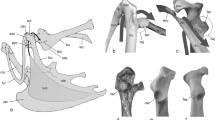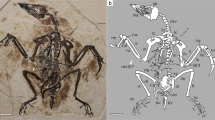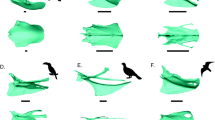Abstract
The evolution of the avian flight musculature is poorly understood and most studies focused on Archaeopteryx. However, important evolutionary changes occurred within Aves, and here the morphology of the pectoral girdle of Mesozoic birds is interpreted in relation to the evolution of the supracoracoideus muscle, which elevates the wing in the upstroke. In the course of avian evolution, the main origin of this muscle shifted from the coracoid onto the sternum. It is hypothesized that resulting space constraints in the cranial portion of the sternum, which also served as the attachment site for the large pectoralis muscle, led to the evolution of a sternal keel. The cranial portion of the sternum of Early Cretaceous Enantiornithes—one of the major clades of Mesozoic birds—lacks a well-developed keel, and the development of the supracoracoideus muscle must have differed from extant birds. This assumption is in concordance with the fact that a triosseal canal, which forms a pulley for the tendon of this muscle in extant birds, appears not to have been developed in Enantiornithes.
Zusammenfassung
Zur Morphologie des Schultergürtels mesozoischer Vögel und der Evolution des Supracoracoideus-Muskels Die Evolution der Flugmuskulatur der Vögel ist nur unzureichend verstanden und die meisten bisherigen Studien konzentrierten sich auf Archaeopteryx. Wichtige evolutionäre Veränderungen traten allerdings innerhalb der Aves auf, und hier wird die Morphologie des Schultergürtels mesozoischer Vögeln in Bezug auf die Entwicklung des Supracoracoideus-Muskels interpretiert, welcher den Flügel im Aufschlag anhebt. Im Laufe der Vogelevolution verlagerte sich der Hauptursprung dieses Muskels vom Coracoid auf das Sternum. Es wird vermutet, dass daraus resultierende Raumbeschränkungen im kranialen Teil des Sternums, welcher auch als Ansatzstelle für den großen Pectoralis-Muskel diente, zur Entstehung eines Brustbeinkiels führten. Ein gut entwickelter Kiel fehlt dem kranialen Bereich des Brustbeins frühkreidezeitlicher Enantiornithes—einer der Hauptgruppen der mesozoischen Vögel—und der Bau des Supracoracoideus-Muskels der Enantiornithes muss sich von den heutigen Vögeln unterschieden haben. Diese Annahme steht im Einklang mit der Tatsache, dass ein triossealer Kanal, welcher die Sehne des Supracoracoideus-Muskels bei den heutigen Vögeln umlenkt, bei den Enantiornithes nicht entwickelt war.




Similar content being viewed by others
References
Biewener AA (2011) Muscle function in avian flight: achieving power and control. Philos Trans R Soc Lond B 66:1496–1506
Bock WJ (2013) The furcula and the evolution of avian flight. Paleontol J 47:1236–1244
Chiappe LM, Calvo JO (1994) Neuquenornis volans, a new Late Cretaceous bird (Enantiornithes: Avisauridae) from Patagonia, Argentina. J Vertebr Paleontol 14:230–246
Chiappe LM, Meng Q (2016) Birds of Stone: Chinese Avian Fossils from the Age of Dinosaurs. Johns Hopkins University Press, Baltimore
Chiappe LM, Walker CA (2002) Skeletal morphology and systematics of the Cretaceous Euenantiornithes (Ornithothoraces: Enantiornithes). In: Chiappe LM, Witmer LM (eds) Mesozoic birds: above the heads of dinosaurs. University of California Press, Berkeley, pp 240–267
Chiappe LM, Zhao B, O’Connor JK, Chunling G, Wang X, Habib M, Marugan-Lobon J, Meng Q, Cheng X (2014) A new specimen of the Early Cretaceous bird Hongshanornis longicresta: insights into the aerodynamics and diet of a basal ornithuromorph. PeerJ 2:e234
Clarke JA (2004) Morphology, phylogenetic taxonomy, and systematics of Ichthyornis and Apatornis (Avialae: Ornithurae). Bull Am Mus Nat Hist 286:1–179
Clarke JA, Zhou Z, Zhang F (2006) Insight into the evolution of avian flight from a new clade of Early Cretaceous ornithurines from China and the morphology of Yixianornis grabaui. J Anat 208:287–308
Elzanowski A (2002) Archaeopterygidae (Upper Jurassic of Germany). In: Chiappe LM, Witmer LM (eds) Mesozoic birds: above the heads of dinosaurs. University of California Press, Berkeley, pp 129–159
Feo TJ, Field DJ, Prum RO (2015) Barb geometry of asymmetrical feathers reveals a transitional morphology in the evolution of avian flight. Proc R Soc Lond B 282:20142864
Fürbringer M (1902) Zur vergleichenden Anatomie des Brustschulterapparates und der Schultermuskeln. Jena Z Naturwiss 36:289–736
George JC, Berger AJ (1966) Avian myology. Academic, New York
Hartman FA (1961) Locomotor mechanics of birds. Smithson Misc Coll 143:1–91
Jasinoski SC, Russell AP, Currie PJ (2006) An integrative phylogenetic and extrapolatory approach to the reconstruction of dromaeosaur (Theropoda: Eumaniraptora) shoulder musculature. Zool J Linn Soc 146:301–344
Li L, Wang J-Q, Hou S-L (2011) A new ornithurine bird (Hongshanornithidae) from the Jiufotang Formation of Chaoyang, Liaoning, China. Vertebr Palasiatica 49:195–200
Martin LD (1995) The Enantiornithes: terrestrial birds of the Cretaceous. Cour Forsch-Inst Senck 181:23–36
Maxwell EE, Larsson HC (2007) Osteology and myology of the wing of the Emu (Dromaius novaehollandiae), and its bearing on the evolution of vestigial structures. J Morphol 268:423–441
Mayr G (2016) Avian evolution: the fossil record of birds and its paleobiological significance. Wiley-Blackwell, Chichester
Mayr G (2017) Evolution of avian breeding strategies and its relation to the habitat preferences of Mesozoic birds. Evol Ecol 31:131–141
Mayr G, Mourer-Chauviré C (2008) The peculiar scapula of the late Eocene Elaphrocnemus phasianus Milne-Edwards, 1892 (Aves, Cariamae). Senck Leth 88:195–198
Mayr G, Pohl B, Hartman S, Peters DS (2007) The tenth skeletal specimen of Archaeopteryx. Zool J Linn Soc 149:97–116
Nesbitt SJ, Turner AH, Spaulding M, Conrad JL, Norell MA (2009) The theropod furcula. J Morphol 270:856–879
O’Connor JK, Gao K-Q, Chiappe LM (2010) A new ornithuromorph (Aves: Ornithothoraces) bird from the Jehol Group indicative of higher-level diversity. J Vertebr Paleontol 30:311–321
O’Connor JK, Chiappe LM, Bell A (2011) Pre-modern birds: avian divergences in the Mesozoic. In: Dyke G, Kaiser G (eds) Living dinosaurs: the evolutionary history of modern birds. Wiley-Blackwell, Chichester, pp 39–114
O’Connor JK, Zheng X-T, Wang X-L, Zhang X-M, Zhou Z-H (2015) The gastral basket in basal birds and their close relatives: size and possible function. Vertebr Palasiatica 53:133–152
Olson SL, Feduccia A (1979) Flight capability and the pectoral girdle of Archaeopteryx. Science 278:247–248
Ostrom JH (1976) Some hypothetical anatomical stages in the evolution of avian flight. Smithson Contrib Paleobiol 27:1–21
Poore SO, Sanchez-Haiman A, Goslow GE (1997) Wing upstroke and the evolution of flapping flight. Nature 387:799–802
Senter P (2006) Scapular orientation in theropods and basal birds, and the origin of flapping flight. Acta Palaeontol Polon 51:305–313
Stegmann B (1964) Die funktionelle Bedeutung des Schlüsselbeines bei den Vögeln. J Ornithol 105:450–463
Sy M (1936) Funktionell-anatomische Untersuchungen am Vogelflügel. J Ornithol 84:199–296
Vazquez RJ (1994) The automating skeletal and muscular mechanisms of the avian wing (Aves). Zoomorphol 114:59–71
Walker CA, Dyke GJ (2009) Euenantiornithine birds from the late Cretaceous of El Brete (Argentina). Ir J Earth Sci 27:15–62
Wang M, Lloyd GT (2016) Rates of morphological evolution are heterogeneous in Early Cretaceous birds. Proc R Soc Lond B 283:20160214
Wang M, Zhou Z (2017) A new adult specimen of the basalmost ornithuromorph bird Archaeorhynchus spathula (Aves: Ornithuromorpha) and its implications for early avian ontogeny. J Syst Palaeontol 15:1–18
Wang X, Chiappe LM, Teng F, Ji Q (2013) Xinghaiornis lini (Aves: Ornithothoraces) from the Early Cretaceous of Liaoning: An example of evolutionary mosaic in early birds. Acta Geol Sin (English Edition) 87:686–689
Wang M, Zhou Z, Zhou S (2016a) A new basal ornithuromorph bird (Aves: Ornithothoraces) from the Early Cretaceous of China with implication for morphology of early Ornithuromorpha. Zool J Linn Soc 176:207–223
Wang Y-M, O’Connor JK, Li D-Q, You H-L (2016b) New information on postcranial skeleton of the Early Cretaceous Gansus yumenensis (Aves: Ornithuromorpha). Hist Biol 28:666–679
Wong M, Carter DR (1988) Mechanical stress and morphogenetic endochondral ossification of the sternum. J Bone Jt Surg Am 70:992–1000
Xu X, Zhou Z, Dudley R, Mackem S, Chuong CM, Erickson GM, Varricchio DJ (2014) An integrative approach to understanding bird origins. Science 346:1253293
Zhang F, Zhou Z (2000) A primitive enantiornithine bird and the origin of feathers. Science 290:1955–1959
Zheng X, O’Connor J, Wang X, Wang M, Zhang X, Zhou Z (2014) On the absence of sternal elements in Anchiornis (Paraves) and Sapeornis (Aves) and the complex early evolution of the avian sternum. Proc Natl Acad Sci USA 111:13900–13905
Zhou Z, Zhang F (2003) Anatomy of the primitive bird Sapeornis chaoyangensis from the Early Cretaceous of Liaoning, China. Can J Earth Sci 40:731–747
Zhou Z, Zhang F, Li Z (2010) A new Lower Cretaceous bird from China and tooth reduction in early avian evolution. Proc R Soc Lond B 277:219–227
Zhou S, Zhou ZH, O’Connor JK (2012) A new toothless ornithurine bird (Schizooura lii gen. et sp. nov.) from the Lower Cretaceous of China. Vertebr Palasiatica 50:9–24
Zhou S, O’Connor JK, Wang M (2014) A new species from an ornithuromorph (Aves: Ornithothoraces) dominated locality of the Jehol Biota. Chin Sci Bull 59:5366–5378
Acknowledgements
I thank Andrzej Elzanowski and two anonymous reviewers, whose comments improved the manuscript.
Author information
Authors and Affiliations
Corresponding author
Additional information
Communicated by F. Bairlein.
Rights and permissions
About this article
Cite this article
Mayr, G. Pectoral girdle morphology of Mesozoic birds and the evolution of the avian supracoracoideus muscle. J Ornithol 158, 859–867 (2017). https://doi.org/10.1007/s10336-017-1451-x
Received:
Revised:
Accepted:
Published:
Issue Date:
DOI: https://doi.org/10.1007/s10336-017-1451-x




